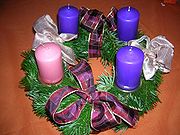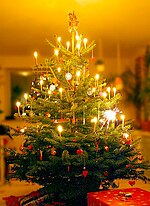Advent
From Wikipedia, the free encyclopedia
| Liturgical year |
|---|
| Western |
| Eastern |
Advent (from the Latin word adventus, meaning "coming") is a season of the Christian church, the period of expectant waiting and preparation for the celebration of the Nativity of Jesus; in other words, the period immediately before Christmas. It is the beginning of the Western liturgical year and commences on Advent Sunday. The Eastern churches begin the liturgical year on 1 September.[1] The Eastern Christian equivalent of Advent is called the Nativity Fast but it differs both in length and observances.
The progression of the season may be marked with an Advent calendar, a practice introduced by German Lutherans. At least in the Roman Catholic and Lutheran calendars, Advent starts on the fourth Sunday before December 25; in other words, the Sunday between November 27 and December 3 inclusive.
Latin adventus is the translation of the Greek word parousia, commonly used in reference to the Second Coming. Christians believe that the season of Advent serves a dual reminder of the original waiting that was done by the Hebrews for the birth of their Messiah as well as the waiting that Christians today endure as they await the second coming of Christ.
Contents |
[edit] Traditions

The theme of readings and teachings during Advent is often to prepare for the Second Coming while commemorating the First Coming of Christ at Christmas. With the view of directing the thoughts of Christians to the first coming of Jesus Christ as Savior, and to his second coming as Judge, special lessons are prescribed for each of the four Sundays in Advent.
The usual liturgical color in Western Christianity for Advent is purple or violet. The color is often used for hangings around the church, on the vestments of the clergy, and often also the tabernacle. On the 3rd Sunday of Advent, Gaudete Sunday, rose may be used instead, referencing the rose used on Laetare Sunday, the 4th Sunday of Lent. In some Anglican and Lutheran churches, blue is the liturgical colour for Advent, a custom traced to the usage of the Church of Sweden (Lutheran) and the medieval Sarum Rite. This color is often referred to as "Sarum blue". Red is used in the Eastern churches.

The "Late Advent Weekdays", December 17-24, mark the singing of the Great Advent 'O antiphons'. These are the antiphons for the Magnificat at Vespers, or Evening Prayer (in the Roman Catholic and Lutheran Churches) and Evensong (in Anglican churches) each day, and mark the forthcoming birth of the Messiah. They form the basis for each verse of the popular Advent hymn, "O come, O come, Emmanuel".
From the 4th century, the season was kept as a period of fasting as strict as that of Lent (commencing in some localities on 11 November; this being the feast day of St. Martin of Tours, the fast became known as "St. Martin's Lent", "St. Martin's Fast" or "the forty days of St. Martin"). The feast day was in many countries a time of frolic and heavy eating, since the 40-day fast began the next day. In the Anglican and Lutheran churches this fasting rule was later relaxed, with the Roman Catholic Church doing likewise later, but still keeping Advent as a season of penitence. In addition to fasting, dancing and similar festivities were forbidden.
In many countries, Advent was long marked by diverse popular observances, some of which still survive. In England, especially in the northern counties, there was a custom (now extinct) for poor women to carry around the "Advent images", two dolls dressed to represent Jesus and the Blessed Virgin Mary. A halfpenny was expected from every one to whom these were exhibited, and bad luck was thought to menace the household not visited by the doll-bearers before Christmas Eve at the latest.
In Normandy, farmers employed children under twelve to run through the fields and orchards armed with torches, setting fire to bundles of straw, and thus it is believed driving out such vermin as are likely to damage the crops. In Italy, among other Advent celebrations, is the entry into Rome in the last days of Advent of the Calabrian pifferari, or bagpipe players, who play before the shrines of Mary, the mother of Jesus, the Italian tradition being that the shepherds played these pipes when they came to the manger at Bethlehem to pay homage to the infant Jesus. It is the second most important tradition behind Easter for Roman Catholics.
[edit] End of the liturgical year
In Anglican churches the Sunday before Advent is sometimes nicknamed Stir-up Sunday after the opening lines of the collect for that day. In the Roman Catholic Church, the final Sunday of the liturgical year before Advent has been celebrated as the Feast of Christ the King since 1969. This feast is now also widely observed in many Anglican, Lutheran and other Protestant churches, sometimes as the Reign of Christ. The First Sunday of Advent, called Levavi is thus the first Sunday of the liturgical year.
[edit] References
- ^ Kallistos (Ware), Bishop (1969), "The Five Cycles", The Festal Menaion, London: Faber and Faber, p. 40
[edit] See also
- Advent wreath
- Fasting and abstinence in the Roman Catholic Church
- Mortification of the flesh in Christianity
- Lent
- Rogation Days
- Great Lent
- Apostles' Fast
- Dormition Fast
- Advent calendar
[edit] External links
| Wikimedia Commons has media related to: Advent |
- Christian Season of Advent at the Christian Resource Institute
- Catholic Encyclopedia: Advent
- Advent history, hymns, virtual wreath at i.UCC online community
- American Catholic: Advent to Epiphany Prayers, calendar and activities
- Liturgical Resources for Advent
- Advent FAQ at the Missouri Synod Lutheran web site
- Advent wreath FAQ at the Evangelical Lutheran Church in America web site
- Advent Resources at The Bible Resource Center, an online ministry of the American Bible Society
- History of Advent



